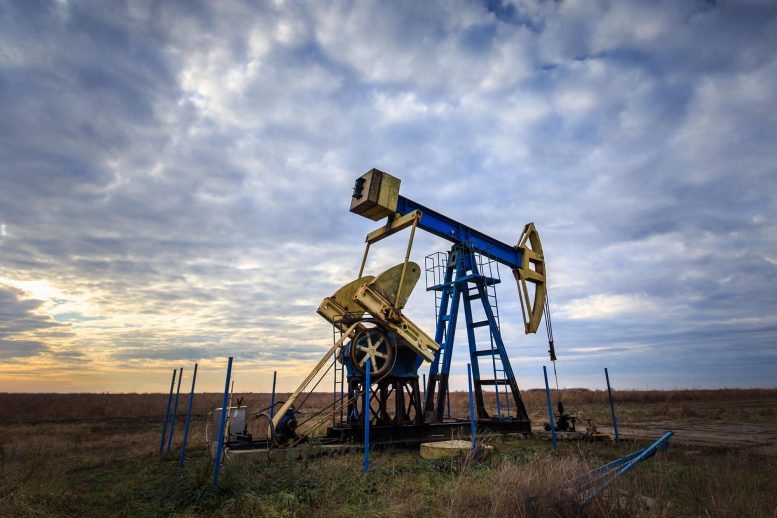
A study led by EES professor Tao Wen is one of the first to use machine learning techniques to holistically assess general water quality data.
Crude oil production and natural gas withdrawals in the United States have lessened the country’s dependence on foreign oil and provided financial relief to U.S. consumers, but have also raised longstanding concerns about environmental damage, such as groundwater contamination.
A researcher in Syracuse University’s College of Arts and Sciences, and a team of scientists from Penn State, have developed a new machine learning technique to holistically assess water quality data in order to detect groundwater samples likely impacted by recent methane leakage during oil and gas production. Using that model, the team concluded that unconventional drilling methods like hydraulic fracturing — or hydrofracking — do not necessarily incur more environmental problems than conventional oil and gas drilling.

Conventional vs. Unconventional Drilling
The two common ways to extract oil and gas in the U.S. are through conventional and unconventional methods. Conventional oil and gas are pumped from easily accessed sources using natural pressure. Conversely, unconventional oil and gas are acquired from hard-to-reach sources through a combination of horizontal drilling and hydraulic fracturing. Hydrofracking extracts natural gas, petroleum and brine from bedrock formations by injecting a mixture of sand, chemicals and water. By drilling into the earth and directing the high-pressure mixture into rock, the gas inside releases and flows out to the head of a well.

Tao Wen, assistant professor of earth and environmental sciences (EES) at Syracuse, recently led a study comparing data from different states to see which method might result in greater contamination of groundwater. They specifically tested levels of methane, which is the primary component of natural gas.
The team selected four U.S. states located in important shale zones to target for their study: Pennsylvania, Colorado, Texas and New York. One of those states — New York — banned the practice of hydrofracking in 2015 following a review by the NYS Department of Health which found significant uncertainties about health, including increased water and air pollution.
Risks of Methane in Groundwater
Wen and his colleagues compiled a large groundwater chemistry dataset from multiple sources including federal agency reports, journal articles, and oil and gas companies. The majority of tested water samples in their study were collected from domestic water wells. Although methane itself is not toxic, Wen says that methane contamination detected in shallow groundwater could be a risk to the relevant homeowner as it could be an explosion hazard, could increase the level of other toxic chemical species like manganese and arsenic, and would contribute to global warming as methane is a greenhouse gas.
Their model used sophisticated algorithms to analyze almost all of the retained geochemistry data in order to predict if a given groundwater sample was negatively impacted by recent oil and gas drilling.
Findings Challenge Assumptions About Fracking
The data comparison showed that methane contamination cases in New York — a state without unconventional drilling but with a high volume of conventional drilling — were similar to that of Pennsylvania — a state with a high volume of unconventional drilling. Wen says this suggests that unconventional drilling methods like fracking do not necessarily lead to more environmental problems than conventional drilling, although this result might be alternatively explained by the different sizes of groundwater chemistry datasets compiled for these two states.
The model also detected a higher rate of methane contamination cases in Pennsylvania than in Colorado and Texas. Wen says this difference could be attributed to different practices when drillers build/drill the oil and gas wells in different states. According to previous research, most of the methane released into the environment from gas wells in the U.S. occurs because the cement that seals the well is not completed along the full lengths of the production casing. However, no data exists to conclude if drillers in those three states use different technology. Wen says this requires further study and review of the drilling data if they become available.
According to Wen, their machine learning model proved to be effective in detecting groundwater contamination, and by applying it to other states/counties with ongoing or planned oil and gas production it will be an important resource for determining the safest methods of gas and oil drilling.
Reference: “Detecting anomalous methane in groundwater within hydrocarbon production areas across the United States” by Tao Wen, Mengqi Liu, Josh Woda, Guanjie Zheng and Susan L. Brantley, 13 May 2021, Water Research.
DOI: 10.1016/j.watres.2021.117236
Wen and his colleagues from Penn State, including Mengqi Liu, a graduate student from the College of Information Sciences and Technology, Josh Woda, a graduate student from Department of Geosciences, Guanjie Zheng, former Ph.D. student from the College of Information Sciences and Technology, and Susan L. Brantley, distinguished professor in the Department of Geosciences and director of Earth and Environmental Systems Institute, recently had their findings published in the journal Water Research.
Never miss a breakthrough: Join the SciTechDaily newsletter.
1 Comment
So they came to this conclusion on how it affects our environment by only looking at how it affects ground water??? What kind of scientific study only looks at one environmental factor to come to its conclusion? What about the effects on foliage, fauna, air contamination, etc…? Too many scientific studies these days are focused too narrowly just so they can justify their findings instead of looking at the full picture. No wonder our planet is doomed